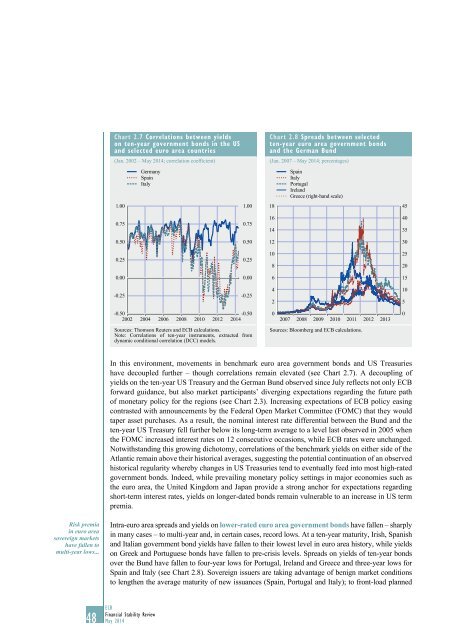You also want an ePaper? Increase the reach of your titles
YUMPU automatically turns print PDFs into web optimized ePapers that Google loves.
Chart 2.7 Correlations between yields<br />
on ten-year government bonds in the US<br />
and selected euro area countries<br />
(Jan. 2002 – May 2014; correlation coefficient)<br />
Chart 2.8 Spreads between selected<br />
ten-year euro area government bonds<br />
and the german Bund<br />
(Jan. 2007 – May 2014; percentages)<br />
Germany<br />
Spain<br />
Italy<br />
Spain<br />
Italy<br />
Portugal<br />
Ireland<br />
Greece (right-hand scale)<br />
1.00<br />
1.00<br />
18<br />
45<br />
0.75<br />
0.75<br />
16<br />
14<br />
40<br />
35<br />
0.50<br />
0.50<br />
12<br />
30<br />
0.25<br />
0.25<br />
10<br />
8<br />
25<br />
20<br />
0.00<br />
0.00<br />
6<br />
15<br />
-0.25<br />
-0.25<br />
4<br />
2<br />
10<br />
5<br />
-0.50<br />
-0.50<br />
2002 2004 2006 2008 2010 2012 2014<br />
Sources: Thomson Reuters and ECB calculations.<br />
Note: Correlations of ten-year instruments, extracted from<br />
dynamic conditional correlation (DCC) models.<br />
0<br />
2007 2008 2009 2010 2011 2012 2013<br />
Sources: Bloomberg and ECB calculations.<br />
0<br />
In this environment, movements in benchmark euro area government bonds and US Treasuries<br />
have decoupled further – though correlations remain elevated (see Chart 2.7). A decoupling of<br />
yields on the ten-year US Treasury and the German Bund observed since July reflects not only ECB<br />
forward guidance, but also market participants’ diverging expectations regarding the future path<br />
of monetary policy for the regions (see Chart 2.3). Increasing expectations of ECB policy easing<br />
contrasted with announcements by the Federal Open Market Committee (FOMC) that they would<br />
taper asset purchases. As a result, the nominal interest rate differential between the Bund and the<br />
ten-year US Treasury fell further below its long-term average to a level last observed in 2005 when<br />
the FOMC increased interest rates on 12 consecutive occasions, while ECB rates were unchanged.<br />
Notwithstanding this growing dichotomy, correlations of the benchmark yields on either side of the<br />
Atlantic remain above their historical averages, suggesting the potential continuation of an observed<br />
historical regularity whereby changes in US Treasuries tend to eventually feed into most high-rated<br />
government bonds. Indeed, while prevailing monetary policy settings in major economies such as<br />
the euro area, the United Kingdom and Japan provide a strong anchor for expectations regarding<br />
short-term interest rates, yields on longer-dated bonds remain vulnerable to an increase in US term<br />
premia.<br />
Risk premia<br />
in euro area<br />
sovereign markets<br />
have fallen to<br />
multi-year lows...<br />
Intra-euro area spreads and yields on lower-rated euro area government bonds have fallen – sharply<br />
in many cases – to multi-year and, in certain cases, record lows. At a ten-year maturity, Irish, Spanish<br />
and Italian government bond yields have fallen to their lowest level in euro area history, while yields<br />
on Greek and Portuguese bonds have fallen to pre-crisis levels. Spreads on yields of ten-year bonds<br />
over the Bund have fallen to four-year lows for Portugal, Ireland and Greece and three-year lows for<br />
Spain and Italy (see Chart 2.8). Sovereign issuers are taking advantage of benign market conditions<br />
to lengthen the average maturity of new issuances (Spain, Portugal and Italy); to front-load planned<br />
ECB<br />
Financial Stability Review<br />
48 May 2014


